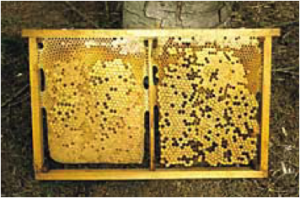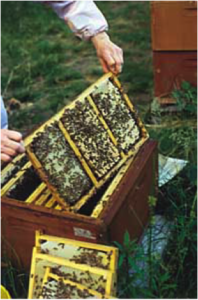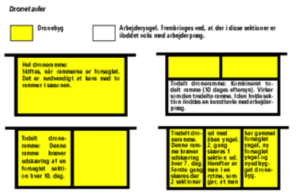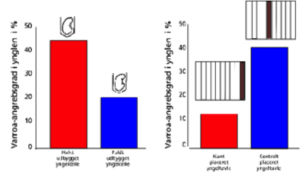Skrevet af: Asger Søgaard Jørgensen
THE REMOVAL OF DRONE BROOD KEEPS THE MITE NUMBERS DOWN THROUGHOUT THE SEASON

In colonies where drone brood removal is practised in the course of the season, there will be three to four times fewer mites than in colonies where this is not practised.
DRONE BROOD REMOVAL
Removal of drone brood is an effective method to limit the propagation of the varroa mite. At the same time it prevents swarming, and it does not effect the honey production.
The varroa mite prefers to breed on drone brood. There are studies which show that between 8 and 10 mites go into drone cells each time 1 goes into a worker cell.
In the drone cell they have more time to get their prodigy developed. While the mite only can get one sexually developed daughter from a worker cell, they can get up to three in a drone cell.

THE DRONE FRAME IS USED THUS
Choose between using two whole frames, frames divided in two or three parts. (See figure)

THE FRAMES WORK BEST THUS
The bees themselves should be allowed to draw the frames themselves from the beginning. German research has shown that more mites come into cells that the bees have to complete than if they were given fully built frames. One of the reasons that more mites come into drone brood is perhaps that worker bees pay more attention to drone brood than to worker brood. There is more building work to be done around the larger drone cells than around the worker brood, and the drone larvae need more food. The mites are transported about in the hive by the worker bees. Since they spend more time around drone brood, this increases the chances of the mites finding the drone cells.
THE DRONE BROOD FRAMES SHOULD BE PLACED INSIDE THE BROOD CLUSTER
German studies have also shown that there were far more varroa mites in frames placed inside the brood cluster than those on the edge of the brood.
In April – May, when drone production is at its highest, there should be so much activity in the colony that the drone frames one sets on the edge of the brood should soon become part of the cluster, as the colony expands.
THE REMOVAL OF DRONE BROOD WORKS
Danish beekeepers have learned that drone removal works. Try opening a frame of drone brood., and see the many mites present. Now from the same colony try opening a frame of worker brood, and here there will be more often than not no mites.
German research has shown that for every mite in a colony in Spring, there can be 50 – 100 mites in Autumn. This means that for every mite removed in Spring there will be proportionally fewer in Autumn.
All in all practical studies have shown that there were 3 – 4 times as many mites in untreated colonies (where drone removal was not carried out) as in treated ones.
Drone removal thus keeps down the mite numbers in periods of honey flow, and postpones that critical point at which the varroa mite possess a real threat to the colony’s existence.
